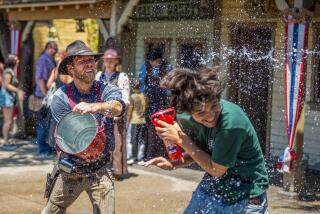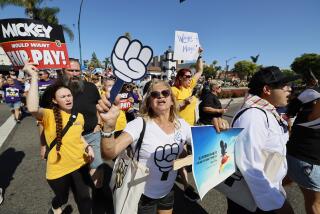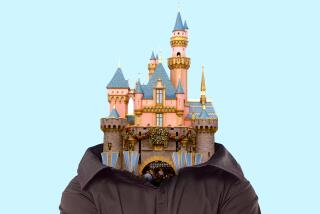Bumpy Ride Ahead in Crusade for Theme Park Safety
- Share via
A year and a quarter have come and gone since a 9-pound metal cleat flew from Disneyland’s sailing ship Columbia and killed someone. The Columbia is back in action. So is the park worker who so tragically docked it. But the state law that was supposed to have ended three decades of virtual free rein by theme park executives--well, that’s still on the drawing board.
And it is on that drawing board that the public’s latest E-ticket ride is transpiring, because, along with the industry’s machinery and labor, the theme park lobbyists are back in action again. With the historic California Permanent Amusement Rides Safety Act signed by the governor but now in the crucial phase during which it must be spelled out in regulations, theme park lawyers are finagling to word things so that, in practice, consumer protection will be kept to the barest of minimums.
For example, according to minutes of a January advisory committee meeting between the state and 45 “interested parties” (at least 40 of whom were from the industry), the theme parks claim that when the state mandated the reporting of injuries requiring treatment “beyond ordinary first aid,” it meant the public should be told only about injuries that end in amputation or overnight hospital stays. This would mean that if, say, your child’s favorite kiddie ride has been breaking the arms and legs of children for the past year, the park owner could leave you in the dark with no embarrassing sanction from the state.
Likewise, there is dispute about how thoroughly the state can inspect rides. The industry’s position, bizarrely, is that the public intended to let the parks pretty much inspect themselves. State lawmakers--understanding that ride inspection is a sophisticated sub-specialty in which there is a limited number of experts--did set up a two-tiered system in which the parks’ inspectors would be overseen by state inspectors. But the industry apparently wants those state inspections to consist chiefly of checking park records and watching the ride run. No going near the equipment, no nuts-and-bolts walk-throughs on new rides. In short, no real loss of control for the parks.
And there are other, broader, arguments regarding penalties: The parks, it turns out, thought the public wanted them to be cited only if someone died or was seriously injured on a ride. Evidently, they believed the state didn’t intend any punishment for, say, failing to fix bad equipment, or replace loose hinges, or report accidents.
*
Now, this is, to repeat, all still on the drawing boards. What’s happening, according to Len Welsh at the state Division of Occupational Safety and Health, is that the state is trying to get consensus among the parks and consumer advocates before it submits final rules for public review. The idea is to get buy-in from everyone so there won’t be undue resistance when it comes time to enforce this long-resisted state law.
But it’s not for nothing that the theme parks beat back regulation in California for 30-odd years, and not for nothing that they have remained unregulated at the federal level as well. (For example, of all the consumer products marketed to American children, theme park rides are, incredibly, the only category that is exempt from the oversight of the U.S. Consumer Products Safety Commission. This despite studies that have shown that the biggest chunk of ride-related injuries--nearly a quarter--happen, not to jerks who stand up on roller coasters and so forth, but to kids under the age of 6.)
The most vocal opponents, Welsh says, have been Disney, Busch Gardens, Universal, Six Flags--in other words, the big tourist parks. This is understandable. They have the most visitors, the deepest pockets for litigious patrons, the most sophisticated rides, the most trade secrets to protect.
It’s tempting to claim that, because they’re big, they’re also the most inclined to play fast and loose with the public’s safety, but the truth is the high end of the theme park industry is also its most safety-conscious end.
Far more problematic, say consumer advocates, are the scores of smaller, local amusement parks where people tend not to make a stink if the Ferris wheel is creaky and there’s rust on the Tilt-a-Whirl. If the big parks dilute the rules for themselves, though, oversight will be diluted everywhere.
The solution is the one Californians like least--involvement--but the industry shouldn’t have the market cornered on lobbying. A consumer Web site--www.saferparks.org--can communicate your concern in time for the next advisory meeting on Tuesday. It also can ask your congressman to support HR 3032, which would bring the parks under the Consumer Products Safety Commission. Don’t leave kids’ safety to theme park executives.
*
Shawn Hubler’s column appears Mondays and Thursdays. Her e-mail address is [email protected].
More to Read
Sign up for The Wild
We’ll help you find the best places to hike, bike and run, as well as the perfect silent spots for meditation and yoga.
You may occasionally receive promotional content from the Los Angeles Times.






